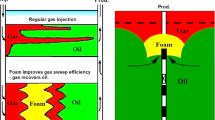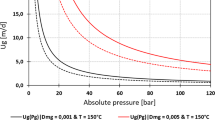Abstract
This study investigates how to determine the optimal supercritical CO2 foam injection strategies, in terms of total injection rate (or injection pressure, equivalently) and injection foam quality, to place injected foams deep and far into the reservoir. Two different mechanisms that limit field foam propagation, such as “conversion from strong foam to weak foam” and “gravity segregation,” are examined separately, and the results are combined together. The first is performed by using a mechanistic foam model based on bubble population balance, while the second is conducted by an analytical model (called Stone and Jenkins model) and reservoir simulations with a commercial software (CMG-STARS). Note that the gas-phase mobility, required as a key input parameter for gravity segregation simulations, is calibrated by the mechanistic model, which is a significant advance in this study.
The results from both mechanisms show in general that foam propagation distance increases with increasing injection pressure or rate (which is often limited by the formation fracturing pressure) and increases with decreasing foam quality down to a certain threshold foam quality below which the distance is not sensitive to foam quality any longer. It is found that the mobilization pressure gradient (i.e., the pressure gradient above which foam films are mobilized to create a population of bubbles) plays a key role to determine the distance. Therefore, the injection of supercritical CO2 foams with lower mobilization pressure gradient should be more favored in field applications. As a step prior to real-world reservoir applications, this study deals with a relatively ideal reservoir (i.e., large homogeneous cylindrical reservoir) focusing on the steady state after foam treatment in the absence of oil.






















Similar content being viewed by others
References
Alvarez, J.M., Rivas, H., Rossen, W.R.: A unified model for steady-state foam behavior at high and low foam qualities. SPE J. 6(03), 325–333 (2001). https://doi.org/10.2118/74141-PA
Attanucci, V., Aslesen, K.S., Hejl, K.A., Wright, C.A.: WAG process optimization in the rangely CO2 miscible flood. In: SPE Annual Technical Conference and Exhibition, 3–6 Oct, Houston, Texas (1993). https://doi.org/10.2118/26622-MS
Blackwell, R.J., Terry, W.M., Rayne, J.R., Lindley, D.C., Henderson, J.R.: Recovery of oil by displacements with water–solvent mixtures. Petrol. Trans. AIME 219, 293–300 (1959)
Buckley, S.E., Leverett, M.C.: Mechanism of fluid displacement in sands. Trans. AIME 146(01), 107–116 (1942). https://doi.org/10.2118/942107-G
Caudle, B.H., Dyes, A.B.: Improving miscible displacement by gas–water injection. Petrol. Trans. AIME 213, 281–284 (1957)
Christensen, J.R., Stenby, E.H., Skauge, A.: Review of WAG field experience. SPE Res. Eval. Eng. 4(02), 97–106 (2001). https://doi.org/10.2118/71203-PA
Computer Modeling Group (CMG): User’s Guide: STARS Advanced Process and Thermal Reservoir Simulator. Computer Modeling Group (CMG), Calgary (2016)
Dietz, D.N.: A theoretical approach to the problem of encroaching and by-passing edge water. Proc. Acad. Sci. 56, 83 (1953)
Dyes, A.B., Caudle, B.H., Erickson, R.A.: Oil production after breakthrough as influenced by mobility ratio. J. Pet. Technol. 6(04), 27–32 (1954). https://doi.org/10.2118/309-G
Friedmann, F., Chen, W.H., Gauglitz, P.A.: Experimental and simulation study of high-temperature foam displacement in porous media. SPE Res. Eng. 6(01), 37–45 (1991). https://doi.org/10.2118/17357-PA
Gauglitz, P.A., Friedmann, F., Kam, S.I., Rossen, W.R.: Foam generation in homogeneous porous media. Chem. Eng. Sci. 57(19), 4037–4052 (2002). https://doi.org/10.1016/S0009-2509(02)00340-8
Georgiadis, A., Maitland, G., Martin Trusler, J., et al.: Interfacial tension measurements of the (H2O + CO2) system at elevated pressures and temperatures. J. Chem. Eng. Data 55(10), 4168–4175 (2010). https://doi.org/10.1021/je100198g
Hill, M.A., Inst, P.F.S.S.: Channeling in packed columns. Chem. Eng. Sci. 1(06), 247–253 (1952). https://doi.org/10.1016/0009-2509(52)87017-4
Holt, T., Vassenden, T.: Reduced gas–water segregation by use of foam. In: European Symposium on Improved Oil Recovery, 20–22 Oct, Hague, Netherlands (1997). https://doi.org/10.3997/2214-4609.201406791
Izadi, M., Kam, S.I.: Bubble population balance modeling to predict propagation distance of CO2 foams in enhanced oil recovery processes. In: SPE Trinidad and Tobago Energy Resources Conference, 25–26 June, Port of Spain, Trinidad and Tobago (2018). https://doi.org/10.2118/191202-MS
Jenkins, M.K.: An analytical model for water/gas miscible displacements. In: Presented at the SPE Enhanced Oil Recovery Symposium, 15–18 April, Tulsa, Oklahoma (1984). https://doi.org/10.2118/12632-MS
Jonas, T.M., Chou, S.I., Vasicek, S.I.: Evaluation of CO2 foam field trial: rangely weber sand unit. In: SPE Annual Technical Conference and Exhibition, 23–26 September, New Orleans, Louisiana (1990). https://doi.org/10.2118/20468-MS
Kam, S.I.: Improved mechanistic foam simulation with foam catastrophe theory. Colloids Surf. A Physicochem. Eng. Asp. 318(1–3), 62–77 (2008). https://doi.org/10.1016/j.colsurfa.2007.12.017
Kam, S.I., Rossen, W.R.: A model for foam generation in homogeneous porous media. SPE J. 8(04), 417–425 (2003). https://doi.org/10.2118/87334-PA
Kovscek, A.R., Patzek, T.W., Radke, C.J.: A mechanistic population balance model for transient and steady-state foam flow in boise sandstone. Chem. Eng. Sci. 50(23), 3783–3799 (1995). https://doi.org/10.1016/0009-2509(95)00199-F
Lacey, J.W., Draper, A.L., Binder, G.G.: Miscible fluid displacement in porous media. Pet. Trans. AIME 213, 76–79 (1958)
Lee, W., Lee, S., Izadi, M., Kam, S.I.: Dimensionality-dependent foam rheological properties: how to go from linear to radial geometry for foam modeling and simulation. SPE J. 21(05), 1669–1687 (2016). https://doi.org/10.2118/175015-PA
Offeringa, J., van der Poel, C.: Displacement of oil from porous media by miscible liquids. J. Pet. Technol. 5(12), 37–43 (1954). https://doi.org/10.2118/416-G
Ortiz Maestre, D.: Mechanistic modeling of nanoparticle-stabilized supercritical CO2 foams and its implication in field-scale EOR applications. Master’s Thesis, Louisiana State University, Baton Rouge, Louisiana (2017)
Osterloh, W.T., Jante, M.J.: Effects of gas and liquid velocity on steady-state foam flow at high temperature. In: SPE/DOE Enhanced Oil Recovery Symposium, 22–24 April, Tulsa, Oklahoma (1992). https://doi.org/10.2118/24179-MS
Rossen, W.R., Shen, C.: Gravity segregation in gas-injection IOR. In: EUROPEC/EAGE Conference and Exhibition, 11–14 June, London, UK (2007). https://doi.org/10.2118/107262-MS
Rossen, W.R., van Duijn, C.J.: Gravity segregation in steady-state horizontal flow in homogeneous reservoirs. J. Pet. Sci. Eng. 43(1–2), 99–111 (2004). https://doi.org/10.1016/j.petrol.2004.01.004
Shi, J.-X., Rossen, W.R.: Simulation and dimensional analysis of foam processes in porous media. SPE Res. Eval. Eng. 1(02), 148–154 (1998). https://doi.org/10.2118/35166-PA
Stone, H.L.: Vertical conformance in an alternating water-miscible gas flood. In: SPE Annual Fall Technical Conference and Exhibition, 26–29 September, New Orleans, Louisiana (1982). https://doi.org/10.2118/11130-MS
Acknowledgements
The authors would like to acknowledge Computer Modeling Group (CMG) for generous donation of CMG-STARS for this study.
Author information
Authors and Affiliations
Corresponding author
Rights and permissions
About this article
Cite this article
Izadi, M., Kam, S.I. Investigating Supercritical CO2 Foam Propagation Distance: Conversion from Strong Foam to Weak Foam vs. Gravity Segregation. Transp Porous Med 131, 223–250 (2020). https://doi.org/10.1007/s11242-018-1125-z
Received:
Accepted:
Published:
Issue Date:
DOI: https://doi.org/10.1007/s11242-018-1125-z





